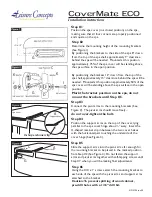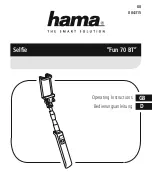
1.
Thought should be given to exactly what you would
like the Light Patrol to do. This may influence your
decision as to where to place it. If for instance you
simply wish the lights to turn on when someone
approaches your front door, the sensor should
monitor the pathway leading to the front door. If
however, you have a particular problem area where
intruders can enter silently and undetected, you need
the Light Patrol to monitor this area.
Added security can be achieved by linking the unit
to both outdoor lights and lights or buzzer inside
the house.
The Light Patrol monitors a 180
°
field of view. In
practice, however, that scanning width may be toowide.
If for instance,
the neighbour’s
driveway is creating
nuisance switching (your unit is triggered by cars and
people next door) the field of view may need to be
restricted.
Four plastic blinkers are supplied. These can be
inserted into the corner/s of the lens and will blind
the sensor by approx. 13
°
for each blinker used. All
four blinkers will reduce field of view to approx. 130
°
.
These may be inserted one side or the other or shared
–
depending on the problem that you are attempting to
overcome. (see figure 1)
2. Before installation make sure that the power is off
on that particular circuit. Remove the fuse or turn off
the circuit breaker at the switchboard.
3. Choose a mounting position approximately 2 metres
above the area that you wish to monitor. (The unit may
be mounted to a height of 4 metres.)
4. Remove the base cover and screw it to the wall or
eave through the two screw holes. If brick or concrete,
wall plugs may be needed. Note:
‘Bottom’
is downward.
Or, in the case of eave mounting,
‘bottom’
is closest to
the wall (facing away from monitoring area).
5. Connect the Light Patrol to the power source
according to the
‘wiring
instructions'. Then screw the
main unit to the base cover.
6. Turn the power on. Start
‘walk test’
(see TEST
MODE on page 3).
Note: Up and down direction of the Light Patrol is
called the
‘tilting angle’.
The bigger the tilting angle
the shorter the detection distance
–
the most ideal tilt
angle is between 0
°
and 10
°
(see figure 2.)
Variable field of view
Avoid straight-on monitoring as a person
may not be detected walking straight
‘into’ the sensing
area.
Better to mount obliquely to the expected
direction of approach so that the person
walks
‘through’
the sensing area.
6
Installation
Figure 2
.
Figure 1
.






















